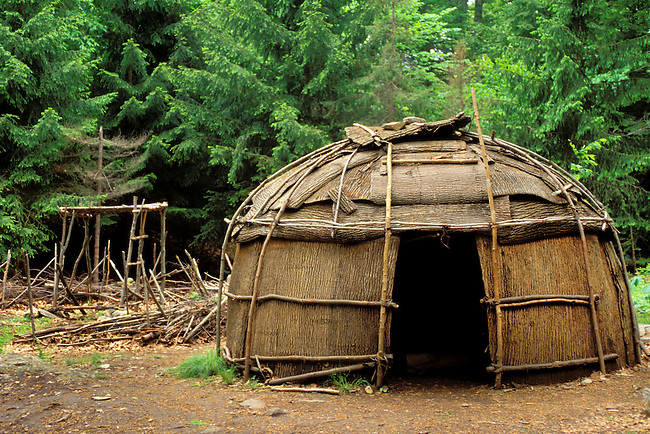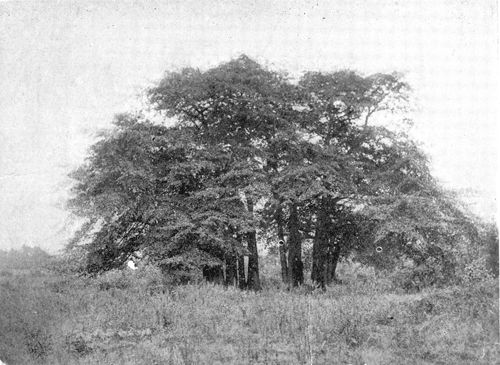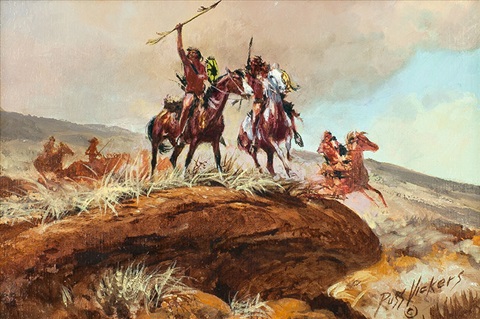In the morning, when they understood that my child was dead they sent for me home to my master’s wigwam1 (by my master in this writing, must be understood Quinnapin, who was a Sagamore23, and married King Phillip’s wife’s sister; not that he first took me, but I was sold to him by another Narragansett Indian, who took me when first I came out of the garrison).

I went to take up my dead child in my arms to carry it with me, but they bid me let it alone; there was no resisting, but go I must and leave it. When I had been at my master’s wigwam, I took the first opportunity I could get to go look after my dead child. When I came I asked them what they had done with it; then they told me it was upon the hill. Then they went and showed me where it was, where I saw the ground was newly digged, and there they told me they had buried it. There I left that child in the wilderness, and must commit it, and myself also in this wilderness condition4, to Him who is above all.5
God having taken away this dear child, I went to see my daughter Mary, who was at this same Indian town, at a wigwam not very far off, though we had little liberty or opportunity to see one another. She was about ten years old, and taken from the door at first by a Praying Ind.6 and afterward sold for a gun. When I came in sight, she would fall aweeping; at which they were provoked, and would not let me come near her, but bade me be gone; which was a heart-cutting word to me.
I had one child dead, another in the wilderness, I knew not where, the third they would not let me come near to: “Me (as he said) have ye bereaved of my Children, Joseph is not, and Simeon is not, and ye will take Benjamin also, all these things are against me.” I could not sit still in this condition, but kept walking from one place to another. And as I was going along, my heart was even overwhelmed with the thoughts of my condition, and that I should have children, and a nation which I knew not, ruled over them.
Whereupon I earnestly entreated the Lord, that He would consider my low estate7, and show me a token for good, and if it were His blessed will, some sign and hope of some relief8 And indeed quickly the Lord answered, in some measure, my poor prayers; for as I was going up and down mourning and lamenting my condition, my son came to me, and asked me how I did. I had not seen him before, since the destruction of the town, and I knew not where he was, till I was informed by himself, that he was amongst a smaller parcel of Indians, whose place was about six miles off. With tears in his eyes, he asked me whether his sister Sarah was dead; and told me he had seen his sister Mary; and prayed me, that I would not be troubled in reference to himself.
The occasion of his coming to see me at this time, was this: there was, as I said, about six miles from us, a small plantation of Indians, where it seems he had been during his captivity; and at this time, there were some forces of the Ind. gathered out of our company, and some also from them (among whom was my son’s master) to go to assault and burn Medfield9. In this time of the absence of his master, his dame brought him to see me. I took this to be some gracious answer to my earnest and unfeigned desire.

The next day, viz. to this, the Indians returned from Medfield, all the company, for those that belonged to the other small company, came through the town that now we were at. But before they came to us, Oh! the outrageous roaring and hooping that there was. They began their din about a mile before they came to us. By their noise and hooping they signified how many they had destroyed (which was at that time twenty-three). Those that were with us at home were gathered together as soon as they heard the hooping, and every time that the other went over their number, these at home gave a shout that the very earth rung again.

And thus they continued till those that had been upon the expedition were come up to the Sagamore’s wigwam; and then, Oh, the hideous insulting and triumphing that there was over Englishmen’s scalps that they had taken (as their manner is) and brought with them.10
A dome shaped dwelling covered with bark, built by Native Americans. ↩
A Native American chief or leader. ↩
https://en.wikipedia.org/wiki/Sachem: for more information behind the history of the word Sagamore and its meaning. ↩
In the Bible, there are many references to the wilderness which often represents trials, tribulations and difficult experiences. It is all about having faith that endures through times of adversity. ↩
One of the most well-known sections in the Bible that references the wilderness is Matthew 4, when Jesus is tested in the wilderness. https://www.biblegateway.com/passage/?search=Matthew%204&version=NIV ↩
A Praying Indian was a term used by English settlers in the 17th century to refer to Native Americans who converted to Christainity. ↩
In the spiritual sense, low estate refers to poor conditions or humility of spirit. This could be a reference to Psalms 136:23 as well, where it speaks of God remembering the Israelites in their low estate or times of distress: https://www.biblegateway.com/passage/?search=Psalm%20136%3A23&version=NIV ↩
Throughout the narrative, it is clear that Rowlandson’s faith provides her with a great deal of comfort while in captivity. Here is a link that provides more background into the Puritan faith of which Mary Rowlandson was a part of: https://en.wikipedia.org/wiki/Puritans ↩
Medfield was attacked on February 21, 1976 https://fountainofmuse.wordpress.com/2011/02/27/medfield-and-the-king-philips-war/ ↩
The tension between Native Americans and English Colonizers increased the amount of scalping that took place, between both parties. There is plenty of symbolism and power held in the act of scalping, for more information on the history of scalping: https://www.britannica.com/topic/scalping ↩
